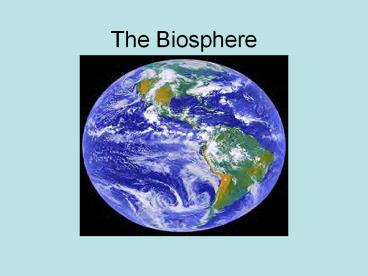The Biosphere - PowerPoint PPT Presentation
1 / 46
Title:
The Biosphere
Description:
The Biosphere Vocabulary Ecology Biosphere Species Population Community Ecosystem Biome Producer Consumer Autotroph Heterotroph Decomposer Learning Target I can ... – PowerPoint PPT presentation
Number of Views:337
Avg rating:3.0/5.0
Title: The Biosphere
1
The Biosphere
2
Vocabulary
Food Chain Food Web Trophic Level Ecological
Pyramid Biogeochemical Cycles Evaporation Transpir
ation Nitrogen Fixation Denitrification Water
Cycle Nitrogen Cycle Carbon Cycle
- Ecology
- Biosphere
- Species
- Population
- Community
- Ecosystem
- Biome
- Producer
- Consumer
- Autotroph
- Heterotroph
- Decomposer
3
Learning Target
- I can compare and contrast the different levels
of organization in ecology
4
What is Ecology?
- It is the study of the interactions between
organisms and their environment - The interaction between the biotic and abiotic
factors
5
Abiotic Factors
- The environments nonliving componentsphysical
and chemical components that shape the environment
6
Abiotic Factors
- Energy source
- Temperature
- Water
- Nutrient Availability
7
Energy Source
- Without a constant source of energy, living
things die!! - What is the primary source of energy for living
things on Earth?
8
You Are Correct! Its the SUN
9
Temperature
- Directly affects metabolism
- All living organisms have a range of temperature
in which they best operate - At or below 0oC and above 45oC will destroy the
enzymes of most organisms.
10
Water
- Is essential for all life.
- Critical for most metabolic chemical reactions
- Helps maintain body temperature
- Helps prevent dehydration
11
Nutrient Availability
- Nutrients are all the chemical substances an
organism needs to sustain its life.
12
Biotic Factors
- All of the living organisms in an area
13
Ecology Levels Of Organization
14
What is the Biosphere?
- It is the areas on Earth where life is found
- It includes any place on land, in the water or in
the atmosphere where organisms live
15
Where are living organisms found in the biosphere?
- Living organisms are found from about 8 km above
the Earth to about 11 km deep in the ocean
16
Ecosystem
- All the abiotic factors and biotic factors found
in a certain place at any time.
17
Community
- All the organisms living in a specific area at a
specific time
18
Population
- A group of individuals of the same species living
in the same area at the same time
19
Species
- A group of organisms so similar that they can
breed and produce fertile offspring
20
Learning Target
- I can compare and contrast the different levels
of organization in ecology.
21
Learning Target
- I can discuss the flow of energy through an
ecosystem. - I can create and discuss a food web.
22
Energy Flow
- The sun is the main source of energy for life on
earth. - lt 1 of all sunlight that reaches earth is used
by living organisms. - What happens to the rest?
23
- Most is reflected off as heat energy.
24
Producers or Autotrophs
- Use sunlight or chemicals to make their own
food. - Examples
25
Photosynthesis
- 6CO2 6H2O C6H12O6 6O2
- Performed on land by plants and in water by algae.
26
Can organisms make their own food without the aid
of sunlight?
- Chemosynthesis using chemical energy to make
carbohydrates. - Usually performed bacteria found in harsh
environments - Ocean vents, volcanoes, hot-acidic environments
27
Consumers or heterotrophs Must get their energy
by eating other organisms
- Herbivores Omnivores
- Decomposers
- Carnivores Detritivores
28
Food Chains
29
Food Webs
- More complex than food chains
- A complex net of interactions among organisms.
(interdependence)
30
Trophic Levels
- Each location or step in a food chain or food web
represents a trophic level. - Examples producers, primary consumers, secondary
consumers, etc.
31
Ecological pyramids
- Only about ten percent of the energy available
within a trophic level is transferred to
oragnisms at the next higher level.
32
Pyramid of Numbers
33
Biomass Pyramids
- Biomass and numbers
34
Learning Targets
- I can discuss the flow of energy through an
ecosystem. - I can create and discuss a food web.
35
Learning Targets
- I can differentiate between the biogeochemical
cycles.
36
Cycles of matter
- Unlike energy, matter is constantly being
recycled in an ecosystem. - Known as biogeochemical cycles
37
(No Transcript)
38
Transpiration
- The release of water from
- the leaves of plants.
- Water is exchanged through
- a plants stomata.
- Evaporation is the second
- process that releases water
- into the atmosphere.
39
Carbon Cycle
- Biological processes (photosynthesis,
respiration, decomposition) - Geochemical processes (volcanoes)
- Biogeochemical (fossil fuels)
- Human activity (factories, deforestation, car
exhaust)
40
(No Transcript)
41
Nitrogen Cycle
- All organisms need nitrogen to live.
- Most abundant gas in atmosphere (80)
- Nitrogen gas is unusable for plants
- Must be fixed or changed into the nitrate or
nitrite form by bacteria in the soil. Known as
nitrogen fixation
42
(No Transcript)
43
Phosphorus cycle
- P is important in the production of DNA and RNA.
- Unlike water,oxygen, and nitrogen, phosphorus is
NOT found in the atmosphere. Found in rocks and
minerals.
44
(No Transcript)
45
Nutrient Limitation
- When a single nutrient is scarce for a particular
ecosystem and limits the growth of organisms in
that ecosystem.
46
Learning Targets
- I can differentiate between the biogeochemical
cycles.































